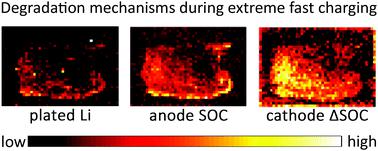当前位置:
X-MOL 学术
›
Energy Environ. Sci.
›
论文详情
Our official English website, www.x-mol.net, welcomes your
feedback! (Note: you will need to create a separate account there.)
Quantification of heterogeneous, irreversible lithium plating in extreme fast charging of lithium-ion batteries
Energy & Environmental Science ( IF 32.4 ) Pub Date : 2021-07-30 , DOI: 10.1039/d1ee01216a Partha P. Paul 1 , Vivek Thampy 1 , Chuntian Cao 1, 2 , Hans-Georg Steinrück 1, 3 , Tanvir R. Tanim 4 , Alison R. Dunlop 5 , Eric J. Dufek 4 , Stephen E. Trask 5 , Andrew N. Jansen 5 , Michael F. Toney 1, 2 , Johanna Nelson Weker 1
Energy & Environmental Science ( IF 32.4 ) Pub Date : 2021-07-30 , DOI: 10.1039/d1ee01216a Partha P. Paul 1 , Vivek Thampy 1 , Chuntian Cao 1, 2 , Hans-Georg Steinrück 1, 3 , Tanvir R. Tanim 4 , Alison R. Dunlop 5 , Eric J. Dufek 4 , Stephen E. Trask 5 , Andrew N. Jansen 5 , Michael F. Toney 1, 2 , Johanna Nelson Weker 1
Affiliation

|
Realization of extreme fast charging (XFC, ≤15 minutes) of lithium-ion batteries is imperative for the widespread adoption of electric vehicles. However, dramatic capacity fading is associated with XFC, limiting its implementation. To quantitatively elucidate the effects of irreversible lithium plating and other degradation mechanisms on the cell capacity, it is important to understand the links between lithium plating and cell degradation at both the local and global (over the full cell) scales. Here, we study the nature of local lithium plating after hundreds of XFC cycles (charging C-rates ranging from 4C to 9C) in industrially-relevant pouch cells using spatially resolved X-ray diffraction. Our results reveal a spatial correlation at the mm scale between irreversible lithium plating on the anode, inactive lithiated graphite phases, and local state-of-charge of the cathode. In regions of plated lithium, additional lithium is locally and irreversibly trapped as lithiated graphite, contributing to the loss of lithium inventory (LLI) and to a local loss of active anode material. The total LLI in the cell from irreversibly plated lithium is linearly correlated to the capacity loss in the batteries after XFC cycling, with a non-zero offset originating from other parasitic side reactions. Finally, at the global (cell) scale, LLI drives the capacity fade, rather than electrode degradation. We anticipate that the understanding of lithium plating and other degradation mechanisms during XFC gained in this work will help lead to new approaches towards designing high-rate batteries in which irreversible lithium plating is minimized.
中文翻译:

锂离子电池极快充电中异质、不可逆锂镀层的量化
实现锂离子电池的极快充电(XFC,≤15分钟)对于电动汽车的广泛应用势在必行。然而,显着的容量衰减与 XFC 相关,限制了它的实施。为了定量阐明不可逆锂电镀和其他降解机制对电池容量的影响,重要的是在局部和全局(全电池)尺度上了解锂电镀与电池降解之间的联系。在这里,我们使用空间分辨 X 射线衍射研究了工业相关软包电池中数百次 XFC 循环(充电 C 速率范围为 4C 到 9C)后局部锂电镀的性质。我们的结果揭示了阳极上不可逆锂电镀、非活性锂化石墨相、和阴极的局部充电状态。在镀锂区域,额外的锂被局部且不可逆地捕获为锂化石墨,导致锂库存 (LLI) 的损失和活性阳极材料的局部损失。来自不可逆镀锂的电池中的总 LLI 与 XFC 循环后电池的容量损失线性相关,非零偏移源自其他寄生副反应。最后,在全球(电池)尺度上,LLI 驱动容量衰减,而不是电极退化。我们预计,在这项工作中获得的对 XFC 过程中锂电镀和其他降解机制的理解将有助于开发设计高倍率电池的新方法,其中不可逆锂电镀最小化。在镀锂区域,额外的锂以锂化石墨的形式被局部且不可逆地捕获,导致锂库存 (LLI) 的损失和活性阳极材料的局部损失。来自不可逆镀锂的电池中的总 LLI 与 XFC 循环后电池的容量损失线性相关,非零偏移源自其他寄生副反应。最后,在全球(电池)尺度上,LLI 驱动容量衰减,而不是电极退化。我们预计,在这项工作中获得的对 XFC 过程中锂电镀和其他降解机制的理解将有助于开发设计高倍率电池的新方法,其中不可逆锂电镀最小化。在镀锂区域,额外的锂以锂化石墨的形式被局部且不可逆地捕获,导致锂库存 (LLI) 的损失和活性阳极材料的局部损失。来自不可逆镀锂的电池中的总 LLI 与 XFC 循环后电池的容量损失线性相关,非零偏移源自其他寄生副反应。最后,在全球(电池)尺度上,LLI 驱动容量衰减,而不是电极退化。我们预计,在这项工作中获得的对 XFC 过程中锂电镀和其他降解机制的理解将有助于开发设计高倍率电池的新方法,其中不可逆锂电镀最小化。导致锂库存(LLI)的损失和活性负极材料的局部损失。来自不可逆镀锂的电池中的总 LLI 与 XFC 循环后电池的容量损失线性相关,非零偏移源自其他寄生副反应。最后,在全球(电池)尺度上,LLI 驱动容量衰减,而不是电极退化。我们预计,在这项工作中获得的对 XFC 过程中锂电镀和其他降解机制的理解将有助于开发设计高倍率电池的新方法,其中不可逆锂电镀最小化。导致锂库存(LLI)的损失和活性负极材料的局部损失。来自不可逆镀锂的电池中的总 LLI 与 XFC 循环后电池的容量损失线性相关,非零偏移源自其他寄生副反应。最后,在全球(电池)尺度上,LLI 驱动容量衰减,而不是电极退化。我们预计,在这项工作中获得的对 XFC 过程中锂电镀和其他降解机制的理解将有助于开发设计高倍率电池的新方法,其中不可逆锂电镀最小化。来自不可逆镀锂的电池中的总 LLI 与 XFC 循环后电池的容量损失线性相关,非零偏移源自其他寄生副反应。最后,在全球(电池)尺度上,LLI 驱动容量衰减,而不是电极退化。我们预计,在这项工作中获得的对 XFC 过程中锂电镀和其他降解机制的理解将有助于开发设计高倍率电池的新方法,其中不可逆锂电镀最小化。来自不可逆镀锂的电池中的总 LLI 与 XFC 循环后电池的容量损失线性相关,非零偏移源自其他寄生副反应。最后,在全球(电池)尺度上,LLI 驱动容量衰减,而不是电极退化。我们预计,在这项工作中获得的对 XFC 过程中锂电镀和其他降解机制的理解将有助于开发设计高倍率电池的新方法,其中不可逆锂电镀最小化。
更新日期:2021-08-04
中文翻译:

锂离子电池极快充电中异质、不可逆锂镀层的量化
实现锂离子电池的极快充电(XFC,≤15分钟)对于电动汽车的广泛应用势在必行。然而,显着的容量衰减与 XFC 相关,限制了它的实施。为了定量阐明不可逆锂电镀和其他降解机制对电池容量的影响,重要的是在局部和全局(全电池)尺度上了解锂电镀与电池降解之间的联系。在这里,我们使用空间分辨 X 射线衍射研究了工业相关软包电池中数百次 XFC 循环(充电 C 速率范围为 4C 到 9C)后局部锂电镀的性质。我们的结果揭示了阳极上不可逆锂电镀、非活性锂化石墨相、和阴极的局部充电状态。在镀锂区域,额外的锂被局部且不可逆地捕获为锂化石墨,导致锂库存 (LLI) 的损失和活性阳极材料的局部损失。来自不可逆镀锂的电池中的总 LLI 与 XFC 循环后电池的容量损失线性相关,非零偏移源自其他寄生副反应。最后,在全球(电池)尺度上,LLI 驱动容量衰减,而不是电极退化。我们预计,在这项工作中获得的对 XFC 过程中锂电镀和其他降解机制的理解将有助于开发设计高倍率电池的新方法,其中不可逆锂电镀最小化。在镀锂区域,额外的锂以锂化石墨的形式被局部且不可逆地捕获,导致锂库存 (LLI) 的损失和活性阳极材料的局部损失。来自不可逆镀锂的电池中的总 LLI 与 XFC 循环后电池的容量损失线性相关,非零偏移源自其他寄生副反应。最后,在全球(电池)尺度上,LLI 驱动容量衰减,而不是电极退化。我们预计,在这项工作中获得的对 XFC 过程中锂电镀和其他降解机制的理解将有助于开发设计高倍率电池的新方法,其中不可逆锂电镀最小化。在镀锂区域,额外的锂以锂化石墨的形式被局部且不可逆地捕获,导致锂库存 (LLI) 的损失和活性阳极材料的局部损失。来自不可逆镀锂的电池中的总 LLI 与 XFC 循环后电池的容量损失线性相关,非零偏移源自其他寄生副反应。最后,在全球(电池)尺度上,LLI 驱动容量衰减,而不是电极退化。我们预计,在这项工作中获得的对 XFC 过程中锂电镀和其他降解机制的理解将有助于开发设计高倍率电池的新方法,其中不可逆锂电镀最小化。导致锂库存(LLI)的损失和活性负极材料的局部损失。来自不可逆镀锂的电池中的总 LLI 与 XFC 循环后电池的容量损失线性相关,非零偏移源自其他寄生副反应。最后,在全球(电池)尺度上,LLI 驱动容量衰减,而不是电极退化。我们预计,在这项工作中获得的对 XFC 过程中锂电镀和其他降解机制的理解将有助于开发设计高倍率电池的新方法,其中不可逆锂电镀最小化。导致锂库存(LLI)的损失和活性负极材料的局部损失。来自不可逆镀锂的电池中的总 LLI 与 XFC 循环后电池的容量损失线性相关,非零偏移源自其他寄生副反应。最后,在全球(电池)尺度上,LLI 驱动容量衰减,而不是电极退化。我们预计,在这项工作中获得的对 XFC 过程中锂电镀和其他降解机制的理解将有助于开发设计高倍率电池的新方法,其中不可逆锂电镀最小化。来自不可逆镀锂的电池中的总 LLI 与 XFC 循环后电池的容量损失线性相关,非零偏移源自其他寄生副反应。最后,在全球(电池)尺度上,LLI 驱动容量衰减,而不是电极退化。我们预计,在这项工作中获得的对 XFC 过程中锂电镀和其他降解机制的理解将有助于开发设计高倍率电池的新方法,其中不可逆锂电镀最小化。来自不可逆镀锂的电池中的总 LLI 与 XFC 循环后电池的容量损失线性相关,非零偏移源自其他寄生副反应。最后,在全球(电池)尺度上,LLI 驱动容量衰减,而不是电极退化。我们预计,在这项工作中获得的对 XFC 过程中锂电镀和其他降解机制的理解将有助于开发设计高倍率电池的新方法,其中不可逆锂电镀最小化。









































 京公网安备 11010802027423号
京公网安备 11010802027423号